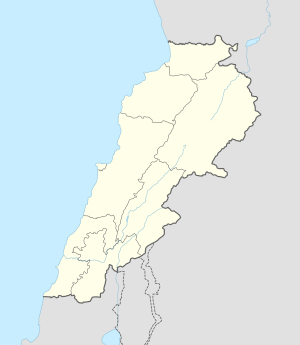Zahlé, Lebanon
| Zahlé | |
|---|---|
 |
|
| Location in Lebanon | |
| Coordinates: 33°50′N 35°55′E / 33.833°N 35.917°ECoordinates: 33°50′N 35°55′E / 33.833°N 35.917°E | |
| Country |
|
| Governorate | Beqaa Governorate |
| Government | |
| • Mayor | Asaad Zoghaib |
| Area | |
| • City | 8 km2 (3 sq mi) |
| • Metro | 90 km2 (30 sq mi) |
| Highest elevation | 1,150 m (3,780 ft) |
| Lowest elevation | 900 m (2,953 ft) |
| Population | |
| • City | 40,000 |
| • Metro | 200,000 |
| Time zone | EET (UTC+2) |
| • Summer (DST) | EEST (UTC+3) |
| Postcode | 1801 |
| Area code(s) | 8 |
Zahlé (also transliterated Zahleh; Lebanese Arabic: زحلة pronounced [ˈzaħle]; Armenian: Զահլէ) is the capital and the largest city of Beqaa Governorate, Lebanon. With around 50,000 inhabitants, it is the fourth largest city in Lebanon after Beirut, Tripoli and Baalbek, and the fifth largest taking the whole urban area (the Jounieh urban area is larger).
Zahlé is located 55 km (34 mi) east of the capital Beirut, close to the Beirut-Damascus road, and lies at the junction of the Lebanon mountains and the Beqaa plateau, at a mean elevation of 1000 m. Zahlé is known as the "Bride of the Beqaa" and "the Neighbor of the Gorge" for its geographical location and attractiveness, but also as "the City of Wine and Poetry" It is famous throughout Lebanon and the region for its pleasant climate, numerous riverside restaurants and quality arak. Its inhabitants are predominantly Greek Catholic and are known as Zahlawis.
The name Zahlé is a Syriac word that refers to "moving places". The occasional landslides that take place on deforested hills around the town are probably at the origin of the name.
There has been human activity in the area for at least 5000 years. In the 18th century, Zahlé was a small village of some 200 houses. Its relative geographic isolation from the local centres of power in Mount Lebanon and Syria made the village not have any significant allies in the region to fall back on in case of conflicts or attacks. Zahlé was burned in 1777 and 1791.
Tradition holds that many Christians quit the Baalbek region in the 18th century for the newer, more secure town of Zahlé on account of the Harfush dynasty's oppression and rapacity, but more critical studies have questioned that interpretation by pointing out that the dynasty was closely allied to the Orthodox Ma‘luf family of Zahlé (where Mustafa Harfush took refuge some years later) and showing that depredations from various quarters as well as Zahlé’s growing commercial attractiveness accounted for Baalbek's decline in the 18th century.What repression there was did not always target the Christian community per se. The Shiite ‘Usayran family, for example, is also said to have left Baalbek then to avoid expropriation by the Harfushes and established itself as one of the premier commercial households of Sidon and later even served as consuls of Iran.
...
Wikipedia

